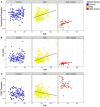An Epigenetically Distinct Subset of Children With Autism Spectrum Disorder Resulting From Differences in Blood Cell Composition
- PMID: 33935932
- PMCID: PMC8085304
- DOI: 10.3389/fneur.2021.612817
An Epigenetically Distinct Subset of Children With Autism Spectrum Disorder Resulting From Differences in Blood Cell Composition
Abstract
Background: Autism spectrum disorder (ASD) is a complex neurodevelopmental disorder that often involves impaired cognition, communication difficulties and restrictive, repetitive behaviors. ASD is extremely heterogeneous both clinically and etiologically, which represents one of the greatest challenges in studying the molecular underpinnings of ASD. While hundreds of ASD-associated genes have been identified that confer varying degrees of risk, no single gene variant accounts for >1% of ASD cases. Notably, a large number of ASD-risk genes function as epigenetic regulators, indicating potential epigenetic dysregulation in ASD. As such, we compared genome-wide DNA methylation (DNAm) in the blood of children with ASD (n = 265) to samples from age- and sex-matched, neurotypical controls (n = 122) using the Illumina Infinium HumanMethylation450 arrays. Results: While DNAm patterns did not distinctly separate ASD cases from controls, our analysis identified an epigenetically unique subset of ASD cases (n = 32); these individuals exhibited significant differential methylation from both controls than the remaining ASD cases. The CpG sites at which this subset was differentially methylated mapped to known ASD risk genes that encode proteins of the nervous and immune systems. Moreover, the observed DNAm differences were attributable to altered blood cell composition, i.e., lower granulocyte proportion and granulocyte-to-lymphocyte ratio in the ASD subset, as compared to the remaining ASD cases and controls. This ASD subset did not differ from the rest of the ASD cases in the frequency or type of high-risk genomic variants. Conclusion: Within our ASD cohort, we identified a subset of individuals that exhibit differential methylation from both controls and the remaining ASD group tightly associated with shifts in immune cell type proportions. This is an important feature that should be assessed in all epigenetic studies of blood cells in ASD. This finding also builds on past reports of changes in the immune systems of children with ASD, supporting the potential role of altered immunological mechanisms in the complex pathophysiology of ASD. The discovery of significant molecular and immunological features in subgroups of individuals with ASD may allow clinicians to better stratify patients, facilitating personalized interventions and improved outcomes.
Keywords: ASD; DNA methylation; blood cell proportion; epigenetics; granulocytes.
Copyright © 2021 Jangjoo, Goodman, Choufani, Trost, Scherer, Kelley, Ayub, Nicolson, Georgiades, Crosbie, Schachar, Anagnostou, Grunebaum and Weksberg.
Conflict of interest statement
The authors declare that the research was conducted in the absence of any commercial or financial relationships that could be construed as a potential conflict of interest.
Figures





Similar articles
-
Functional DNA methylation signatures for autism spectrum disorder genomic risk loci: 16p11.2 deletions and CHD8 variants.Clin Epigenetics. 2019 Jul 16;11(1):103. doi: 10.1186/s13148-019-0684-3. Clin Epigenetics. 2019. PMID: 31311581 Free PMC article.
-
Integrated genome-wide Alu methylation and transcriptome profiling analyses reveal novel epigenetic regulatory networks associated with autism spectrum disorder.Mol Autism. 2018 Apr 16;9:27. doi: 10.1186/s13229-018-0213-9. eCollection 2018. Mol Autism. 2018. PMID: 29686828 Free PMC article.
-
Case-control meta-analysis of blood DNA methylation and autism spectrum disorder.Mol Autism. 2018 Jun 28;9:40. doi: 10.1186/s13229-018-0224-6. eCollection 2018. Mol Autism. 2018. PMID: 29988321 Free PMC article.
-
Epigenomic signatures reveal mechanistic clues and predictive markers for autism spectrum disorder.Mol Psychiatry. 2023 May;28(5):1890-1901. doi: 10.1038/s41380-022-01917-9. Epub 2023 Jan 17. Mol Psychiatry. 2023. PMID: 36650278 Free PMC article. Review.
-
Variation in Gene Expression in Autism Spectrum Disorders: An Extensive Review of Transcriptomic Studies.Front Neurosci. 2017 Jan 5;10:601. doi: 10.3389/fnins.2016.00601. eCollection 2016. Front Neurosci. 2017. PMID: 28105001 Free PMC article. Review.
Cited by
-
Using developmental regression to reorganize the clinical importance of autistic atypicalities.Transl Psychiatry. 2022 Dec 1;12(1):498. doi: 10.1038/s41398-022-02263-8. Transl Psychiatry. 2022. PMID: 36456542 Free PMC article.
-
Re-emerging concepts of immune dysregulation in autism spectrum disorders.Front Psychiatry. 2022 Oct 19;13:1006612. doi: 10.3389/fpsyt.2022.1006612. eCollection 2022. Front Psychiatry. 2022. PMID: 36339838 Free PMC article. Review.
-
Candidate biomarkers from the integration of methylation and gene expression in discordant autistic sibling pairs.Transl Psychiatry. 2023 Apr 3;13(1):109. doi: 10.1038/s41398-023-02407-4. Transl Psychiatry. 2023. PMID: 37012247 Free PMC article.
-
An epigenetic rheostat of experience: DNA methylation of OXTR as a mechanism of early life allostasis.Compr Psychoneuroendocrinol. 2021 Nov 14;8:100098. doi: 10.1016/j.cpnec.2021.100098. eCollection 2021 Nov. Compr Psychoneuroendocrinol. 2021. PMID: 35757665 Free PMC article. Review.
-
Categorical misalignment: Making autism(s) in big data biobanking.Soc Stud Sci. 2025 Apr;55(2):209-237. doi: 10.1177/03063127241288223. Epub 2024 Oct 7. Soc Stud Sci. 2025. PMID: 39370865 Free PMC article.
References
LinkOut - more resources
Full Text Sources
Other Literature Sources
Research Materials
Miscellaneous

